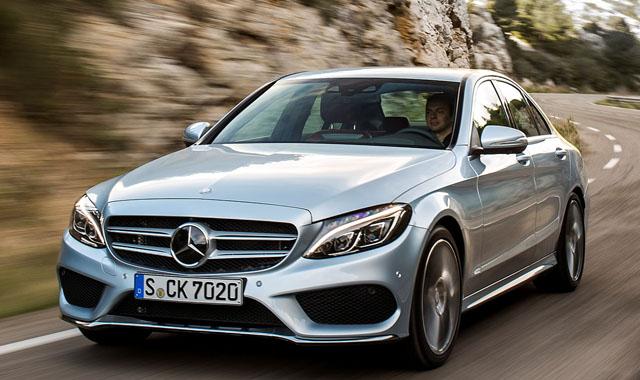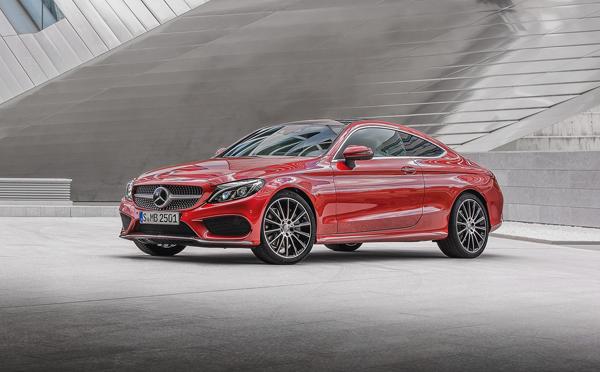You are here
From junior executive to compact luxury
By Ghaith Madadha - Jan 19,2015 - Last updated at Jan 19,2015

The first in its compact executive saloon segment to offer optional air suspension, the new Mercedes-Benz C-Class is a more technologically advanced and well-kitted successor model with a distinctly more luxury-oriented approach than its predecessor.
Designed with familial resemblance to Mercedes’ full-size S Class luxury saloon, and with the recently launched and smaller CLA Class being more overtly sporty, the C Class embraces Mercedes’ elegantly luxurious brand characteristics to a greater extent than its predecessor.
Larger and roomier than before, the new C Class’ greater content lightweight aluminium also improves its efficiency, while its two-litre turbocharged engine offers frugal fuel consumption, brisk performance and a light and agile front end.
Toned and elegant
Elegantly flowing with discretely sporting cues, the new C Class takes Mercedes’ S Class flagship as its design staring point and consolidates the brand’s classy characteristics in this segment. Featuring elegant curves, sporty proportions and smoothly toned body surfaces, the confident and classy C Class features a long wheel arch to A pillar distance, which conveys a distinctly luxurious aesthetic within a compact frame.
With a wide grille extending and subtly raised bonnet centre, the C Class’ fluid design includes a descending side crease that begins from the headlights’ LED strips. From rear view, a gently arced roofline and strong shoulders fluently converge to a tapered-in boot.
Driven in C250 AMG guise, the C Class smooth and flowing design is given a more sportingly assertive flavour, but does so without compromising the model’s uncomplicatedly elegant lines and compact dimensions. The AMG bodykit’s twin-slat grille and grille embedded tri-star combine with faux brake vents and wider intakes for a more urgent athletic and sense of dynamic tension.
Meanwhile, the new C Class uses 50 per cent aluminium body and frame construction — rather than its predecessor’s 10 per cent — which results in an overall 100kg weight loss, depending on model. Combined with low CD0.27 aerodynamics and efficient electric-assisted rack and pinion steering this allows for up to 20 per cent fuel consumption reductions.
Punchy and frugal
Powered by the most powerful version of Mercedes’ two-litre turbocharged direct injection four-cylinder engines available to the C Class, the C250 develops 208BHP at 5,500rpm and 258lb/ft throughout a broad 1,200-4,000rpm band. With its turbos spooling up quickly the C250 suffers little by way of low-end turbo lag, but with a muscular and wide peak torque band, can overtake with quick confidence.
Underwritten by a wide torque band, the C250’s power develops eagerly and offers top-end responsiveness. Weighing in at 1,480kg, the C250 accelerate from standstill to 100km/h in 6.6 seconds and onto a potential 250km/h top speed, and returns frugal 5.3l/100km fuel consumption and 123g/km carbon dioxide emissions on the combined cycle.
With smooth and responsive delivery, the C250’s two-litre turbocharged engine drives the rear wheels through a seven-speed automatic gearbox with a wide range of ratios for brisk performance and efficiency when cruising. Smooth and quick shifting, the C250 features several gearbox and throttle response settings.
Best driven in its sportier settings where concise gear shift points are at higher revs and while throttle inputs more deliberate. The C250 can also be driven in a manual sequential mode with steering-mounted paddle shifters. Located behind the paddle shifters, the C Class’ steering column mounted gear lever provides a luxury car-like ambiance and frees up space on the centre console.
Comfort and balance
Built using 50 per cent aluminium content, the C Class’ rigid and lightweight construction lends itself to handling, performance, refinement, fuel efficiency and crash safety benefits. A balanced front engine rear-drive platform with sophisticated all-round multi-link suspension is combined with optional air damping, which is usually reserved for range-topping luxury cars.
With a small and light engine in front and rear-drive, the C250 AMG is tidy turning-in, balanced, agile and composed through countryside switchbacks, while optional low profile 225/45R18 front and 245/40R18 rear tyres provides committed lateral grip. The C Class’ variable speed and assistance electromechanical steering is direct and firm on B-roads and manoeuvrability light in town.
With self-levelling air suspension the C250 is controlled on acceleration and braking, with squat, dive and cornering body lean kept well in check. Ride quality is smooth and comfortable over rough tarmac, settled on rebound from dips and crests, and reassuringly planted and refined at high speed motorways.
The C250’s actively variable air damping features four progressive suspension settings to allow one to choose how comfortably supple or firmly controlled it rides. In its element on a test drive on the French Riviera and adjacent country and mountain roads between Salon-de-Provence and Aix-en-Provence, the C250 AMG was manoeuvrable an busy Marseille and narrow village roads, and eager and composed through fast, narrow and tight lanes.
Classy and convenient
Lighter but larger than its predecessor, the contemporary C Class is 40mm wider and 80mm longer at the wheelbase for improved cabin space, while boot volume increases to 480 litres. Comfortable and quiet, the C Class’s well appointed and refined cabin features ergonomic and versatile seat and steering adjustability, and can easily accommodate drivers of wildly varying sizes and heights.
A classier and more up-market C Class, the driven AMG trim version’s cabin appointments include good woods, textures and rich red leather upholstery on the specific demo car. Sportier touches include a chunky steering wheel, supportive seats, conical dials, and circular vents on an upright dashboard.
The latest C Class features an extensive list of standard and optional equipment covering a range of creature comforts and high-tech infotainment, driver assistance and semi-autonomous safety systems.
Such systems include cross-traffic sensing brake assistance, stop/start cruise control to facilitate smoother traffic flow and avoid low speed collisions, lane keeping assistance and a collision prevention system to prevent collision at up to 40km/h and mitigate collision severity up to 200km/h, and more nuanced airbag deployment for enhanced safety.
Also available are GPS-connected climate control, semi-autonomous parking, intelligent sign recognition and highbeam functions. A tablet-style infotainment touchscreen is Internet-enabled and — along with other vehicle functions — can be accessed through a centre console touchpad and rotary selector.
|
TECHNICAL SPECIFICATIONS
Engine: 2 litre, turbocharged, in line 4 cylinders Bore x stroke: 83 x 92mm Compression ratio: 9.8:1 Valve train: 16 valve, DOHC, direct injection Gearbox: 7-speed automatic, rear-wheel-drive Ratios: 1st 4.38:1 2nd 2.86:1 3rd 1.92:1 4th 1.37:1 5th 1:1 6th 0.82:1 7th 0.73:1 Reverse: 1st 3.42:1/2nd 2.23:1 Final drive ratio: 3.07:1 0-100 km/h: 6.6 seconds Maximum speed: 250km/h Power, BHP (PS) [kW]: 208 (211) [155] @5,500rpm Specific power: 104.5BHP/litre Power-to-weight: 140.5BHP/tonne Torque, lb/ft (Nm): 258 (350) @ 1,200-4,000rpm Specific torque: 175.8Nm/litre Torque-to-weight: 236.5Nm/tonne Fuel consumption, combined: 5.3 litres/100km CO2 emissions, combined: 123g/km Fuel tank: 66 litres Length: 4,686mm Width: 1,810mm Height: 1,442mm Wheelbase: 2,840mm Track, F/R: 1,584/1,573mm Aerodynamic drag co-efficiency: 0.27 Boot capacity: 480 litres Payload: 565kg Kerb weight: 1,480kg Steering: Power assisted, rack and pinion Turning circle: 11.22-metres Suspension: Multi-link, adaptive air suspension, anti-roll bars Brakes, F/R: Ventilated discs/discs Tyres, F/R: 225/45R18/245/40R18 (optional, as tested) |
Related Articles
Larger and more comfortable, luxurious and advanced, the latest generation Mercedes C-Class however boasts significant weight, fuel consumption and emissions reductions.
Launched earlier this year the latest incarnation of Mercedes-Benz junior executive C-Class model line is a larger and more luxurious and high tech offering than the car it replaces.
First revealed late last year at the Frankfurt Motor Show and making its regional Middle East debut earlier this month, the Mercedes-Benz C-



















